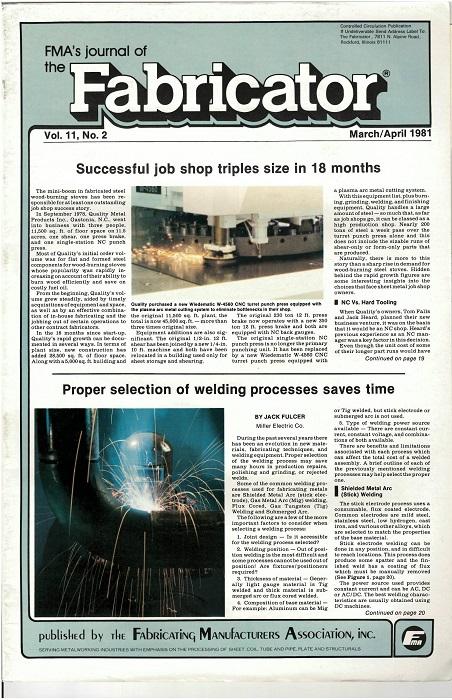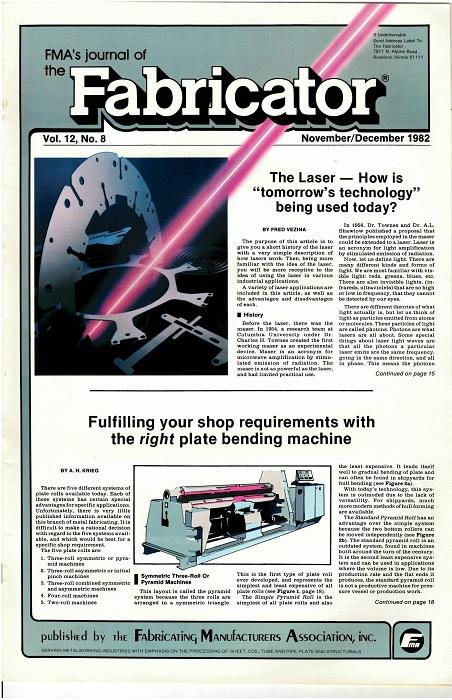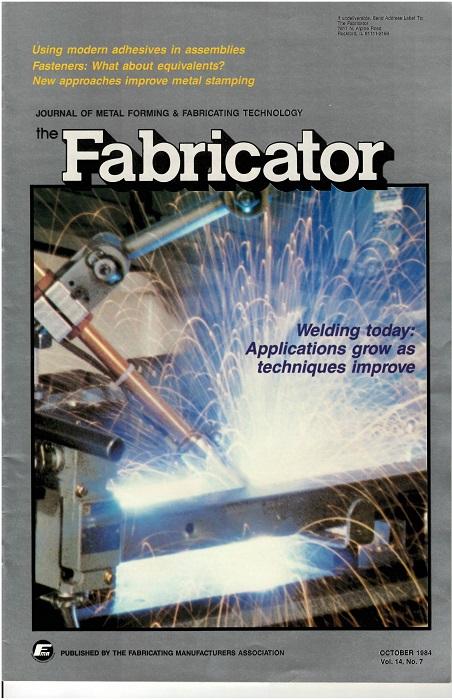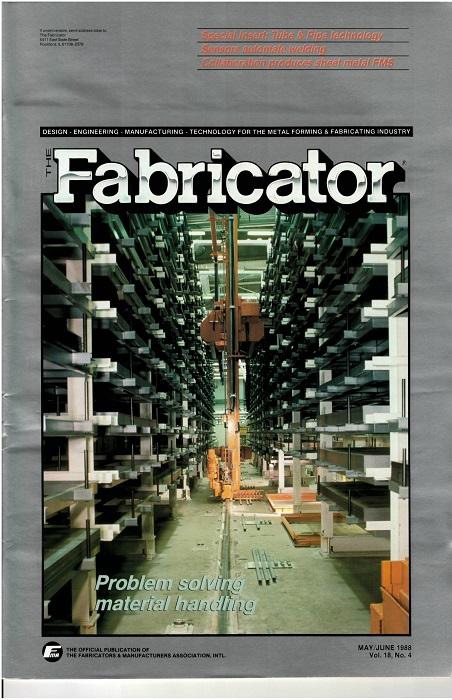Editor-in-Chief
- FMA
- The Fabricator
- FABTECH
- Canadian Metalworking
Categories
- Additive Manufacturing
- Aluminum Welding
- Arc Welding
- Assembly and Joining
- Automation and Robotics
- Bending and Forming
- Consumables
- Cutting and Weld Prep
- Electric Vehicles
- En Español
- Finishing
- Hydroforming
- Laser Cutting
- Laser Welding
- Machining
- Manufacturing Software
- Materials Handling
- Metals/Materials
- Oxyfuel Cutting
- Plasma Cutting
- Power Tools
- Punching and Other Holemaking
- Roll Forming
- Safety
- Sawing
- Shearing
- Shop Management
- Testing and Measuring
- Tube and Pipe Fabrication
- Tube and Pipe Production
- Waterjet Cutting
Industry Directory
Webcasts
Podcasts
FAB 40
Advertise
Subscribe
Account Login
Search
1980s: The search for productivity in metal fabrication
A few decades ago, U.S. fabricators questioned what it meant to be a modern manufacturer
- By Dan Davis
- April 20, 2020
- Article
- Shop Management
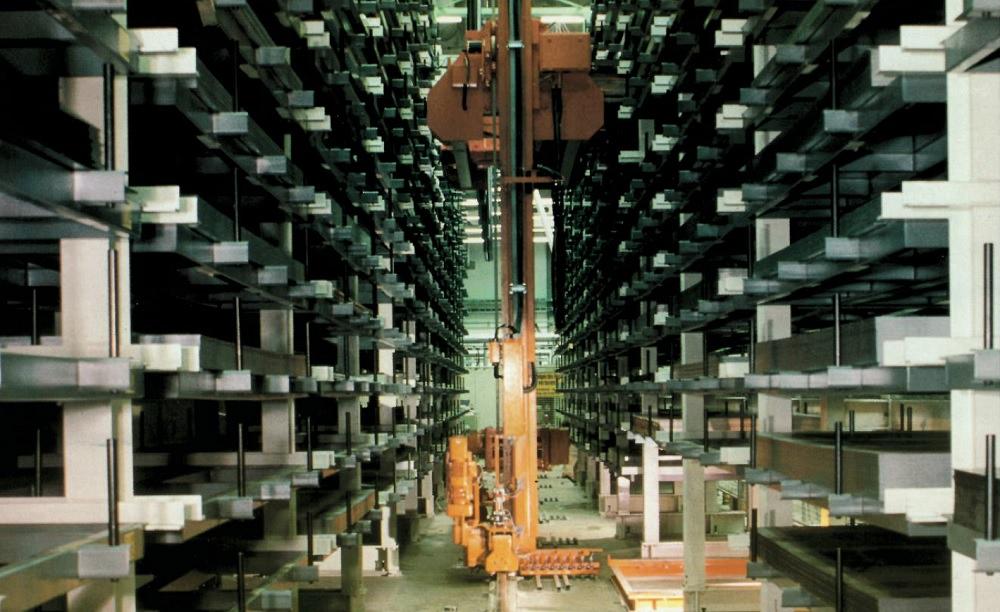
In the 1980s metal fabricators questioned what they needed to do to be as productive as peers in Japan and Germany.
Editor's Note: This is the second installment looking at how the modern metal fabrication industry has impacted each decade since 1970, the same era that The FABRICATOR magazine launched. Read about the 1970s, 1990s, 2000s, and 2010s.
By now you may have noticed that The FABRICATOR is celebrating its 50th anniversary this year. We reviewed the publication’s first decade in the February and learned that modern metal fabricating came to fruition with the emergence of CNC technology and a new interest in streamlining production in the face of growing international competition.
Well, if the 1970s was about laying the foundation for modern fabricating, the 1980s was about its growing pains. Fabricating technology was continually improving, and industry players began to question the way “things were always done” as many felt that the U.S. was losing its manufacturing might to more productive foreign competitors.
The hair may have been big and the fashions a bit gawdy (for those that remember the TV show “Miami Vice”) in the 1980s, but for the metal fabricator, the fashion was hard to notice. The fabricating business was becoming more challenging as customers were becoming more demanding. The FABRICATOR documented this transition throughout the decade.
January-February 1980
Fear of Change Means Failure at Business
It’s an incredible coincidence that John Kensey of Eaton Leonard Corp. penned a guest editorial in The FABRICATOR’s first issue of the 1980s asking metal fabricators to be more open to change. The words are prescient today as fabricators have to keep up with not only changes in fabricating technology and increasing customer expectations, but also rapid change in the way people interact in business-to-business settings.
“With rare and refreshing exceptions, our own experience as a manufacturer of advanced automation tube-bending equipment has been that U.S. firms can be interested in new technology and upgraded machinery on two grounds only. First, it must show large immediate ‘hard-dollar’ return on investment from savings in labor and materials. Little or no weight is apt to be given to such ‘soft savings’ as potential inventory reductions, space requirement reduction, reduced employees turnover as a result of less tedious, more rewarding work; reduced inspection costs; and improved customer satisfaction as a result of more rapid response time. Second, it must conform to traditionally defined plant layout and organizational conventions—that is, it must not cause major change.
“As long as we offered new tools that could increase production immediately without requiring extensive plant rearrangement, or impacting the company’s distribution system or lines of authority, we could count on a ready reception. Now, however, we are developing equipment which can potentially offer enormously increasing productivity but whose productive potential may not be realizable without thoroughgoing rethinking of the company’s traditional ways of doing things,” Kensey wrote.
March-April 1980
Longtime Contributor
You’ll see a lot of back-to-basics articles in The FABRICATOR and its sister publications. New people are always entering the industry, and new subscribers are always joining the readership. It’s been a recipe for success over the years.
Jack Fulcer of Miller Electric Mfg. Co. wrote an article in this particular issue on “Fundamentals of Solid State Welding.” That’s not so out of the ordinary, if you consider only the one article. But Fulcer wrote an article for The WELDER in 2009. That’s almost 30 years between bylined contributions. That’s worthy of a tip of the welder’s hood.
July-August 1980
FABTECH Is Born!
What is now North America’s largest metal fabricating technology event was introduced to the world in an announcement on the front page of the July-August 1980 edition of The FABRICATOR. The Fabricating Manufacturers Association, which the Fabricators & Manufacturers Association was known as at the time, and the Society of Manufacturing Engineers viewed the tradeshow as not only a showcase for machinery, but also a chance for fabricators to learn about the newest technologies, services, and processes in more than 50 technical presentations.
“For many years, industry has asked for the opportunity to feature all fabricating disciplines in one event; we are most pleased that FABTECH International will accomplish the request,” the news item said.
And where would this very first important industry event take place? Cleveland!
September/October 1980
Trying to Boost Productivity
The early 1980s were a time when U.S. manufacturers were really trying to find their footing on the international stage. A report from the Joint Economic Committee from 1979 said that output per man-hour took its deepest plunge since the government began compiling statistics in 1947. That prompted everyone in manufacturing to ask the same question, “What can we do to boost productivity?”
George Goudreault of AP Parts Co. and director of the Fabricating Manufacturers Association had his own idea. Instead of focusing on direct labor as a whole and looking to boost productivity by tightening processes or investing in automated equipment, he suggested concentrating on the individual contributions throughout the organization.
“In a broader definition, today we must look at the total opportunities that exist in the phase of our businesses. If we view the productivity problem from this perspective and look at total input, we can see that every employee has an opportunity to contribute,” he wrote in a guest editorial titled “Productivity—or Poverty.”
Ask people who actually do the work and know how work flow really occurs. It’s the basic lesson of continuous improvement. Some learned the lesson way before others, however.
March/April 1981
The Story of the Shop That Tripled Its Size
It’s September 1978 and Quality Metal Products Inc., Gastonia, N.C., went into business with three people, one shear, one press brake, and one single-station punch press. Eighteen months later, the company expanded to triple its floor space and added more modern fabricating equipment, such as a 350-ton, 12-ft. press brake with an NC backgauge and a Wiedematic W-4560 CNC turret punch press equipped with a plasma cutting system.
The case study focused on the shop’s new punch press. The high-speed machine could produce 175 hits per minute in 1-in. moves. “The 45-ton punch press saved our life. It boosted output immediately by 15%,” said Tom Falls.
Probably more interesting, however, was a discussion on other steps Quality Metal Products was taking to remain competitive. Instead of relying on its own shearing capabilities for all jobs, it had recently started buying custom blanks from a shearing house to supply production runs that reached at least 10,000 pieces a week. (Those were the days!) The Wiedematic W-4560’s plasma cutting capability gave the shop the ability to target new customers, moving beyond its main product line of wood-burning steel stoves. For example, a 0.25-in.-thick stainless steel part used for agricultural purposes was being cut on the new equipment instead of being punched out on a press brake with an expensive die set.
January/February 1982
The Search for Automated Panel Fabrication
Many a fabricating business was built on the production of boxes and cabinets. This is not a new story.
In the early 1980s, fabricators were looking for the best way to make these items. A front-page story in The FABRICATOR detailed how Gestetner Ltd. in the U.K. found its answer in a triple-action Tranemo hydraulic press for double forming of each panel edge. The process was selected over roll forming and blanking followed by press brake forming. An in-house tool and die shop for tooling maintenance also played a large part.
The combination of Swedish-made folding tooling for panel production and the new press helped to produce panels at a much faster rate than would have been possible by using the press brake. In fact, the stamping press produced complete cabinet panels that required no additional downstream processing.
May/June 1982
There Is No “I” in Team!
Again, the metal fabricating community was in the midst of an identity crisis as machine tool manufacturers in other countries were getting more aggressive in selling equipment in the U.S. New competitors were showing up every day. That led William Watt of Bloomer-Flake Inc., a member of the Fabricating Manufacturers Association, to ask, “Why are we not competitive?” in a guest editorial. He said it came down to getting people to work together, which was a task for management, albeit not a simple one.
“Our society has nurtured these desires by giving importance to increased material benefits and stature in our society. It would be unrealistic to believe that we could change these goals of our society, but we must override them by developing a strong desire for each person to find fulfillment and satisfaction by helping each other to accomplish this task more effectively,” he wrote.
“If we as individuals, and as managers, can instill this will to help each other, we will be amazed at the new ideas on cutting costs, reducing errors, becoming more competitive. Now, we are competitive, a fulfilled and proud people.”
As today’s metal fabricators look for help, local and state officials have assisted in many instances with investment in training programs. The same was occurring almost 40 years ago.
A vocational startup and continuing educational program sponsored by the state of Mississippi was helping to supply welders and machine operators to the Cives Steel Co. fabricating facility in Rosedale, Miss. The program must have done well, as the facility is still producing structural steel parts today.
November/December 1982
The Laser Makes Another Appearance
Fred Vienza with Strippit Division, Houdaille Industries Inc., provided a history of the laser in “The Laser—How is ‘tomorrow’s technology’ being used today?”
“The purpose of this article is to give you a short history of the laser with a very simple description of how lasers work. Then, being more familiar with the idea of the laser, you will be more receptive to the idea of using the laser in various industrial applications,” he wrote.
What was covered? The publication had a discussion about lasers used in communications, measurements medicine, and space and military programs. It concluded with the simple statement that lasers could be used to cut a variety of materials in industrial applications, including sheet metal. That might have been one of the biggest understatements ever to be printed in the magazine.
January/February 1984
The Future of Computing Power in Fabricating
The graphic that accompanied the story “Computer technology and the sheet metal industry” looks as dated as the story’s title sounds, but information provided by Donald Prill of The LVD Corp. was prescient. He documented a lot of the changes that were to happen to modern metal fabricating technology.
Computer-controlled backgauges on a press brake? Check. Programming of machines while sitting in front of a computer? That’s covered. The possibility of using that computer to coordinate communication between a robot and a press brake? That’s in there as well.
“These few examples show that computer technology has stimulated designers and manufacturers to develop substantial innovations with respect to the control and operation of modern press brakes. Flexibility enables the designers and manufacturers to meet the user’s special wishes,” Prill wrote.
March 1984
The Pull-back Device?
The Occupational Safety and Health Administration was still a relatively new agency in the early 1980s. As a result, The FABRICATOR spent a lot of time writing about machine guarding. In fact, an article during this time suggested that 75% to 80% of the several hundred thousand stamping presses in the U.S. at the time did not comply with OSHA press safety requirements, even though the deadline for full compliance was in 1975.
Photoelectric light curtains were a possible safety tool back then, as they are now. Pull-back devices were another thing, however. There is a reason you don’t see them today.
Have you ever heard of being chained to your workstation? In the 1980s that was not a metaphor. These setups were designed to either prevent the operator from ever reaching into the point of operation or, if the hands were inadvertently located in that area, to pull them out before the dies closed. As part of this safety system, wristlets had to be attached to each of the operator’s hands. The attachments were usually made of nylon material and attached to the pulling cables by a snap assembly. Happily, these are rarely seen today.
July/August 1984
Fabricating’s Future—Not So Much
The article “Flexible manufacturing systems—fabricating’s future” theorized fab shops in the coming decades would have machine tools, connected by automated material handling systems, being fed raw material on one end and producing completed parts on the back end. With 80% of metal components being produced in the U.S. at that time falling into small to medium lot sizes, one to 10,000 pieces, such systems seemed to make sense for fabricators.
That theory wasn’t completely off, but these flexible manufacturing systems are hardly ubiquitous today. The human in metal fabrication has proven to be a pretty flexible part of a job shop’s ability to jump from one small project to another. It’s hard to see any future in fabricating that doesn’t involve the human touch.
October 1984
A Successful Robotic Welding Installation
A successful robotic welding installation at Amedco Health Care Inc. in St. Louis was shared with the publication’s subscribers. The manufacturer of hospital beds had an automated welding station consisting of a three-station pedestal setup for the bed frame components, a GE P50 process robot, and Miller Electric gas metal arc welding equipment. The robotic welder was used to weld component parts to the bed frame. Each of the bed frames consisted of approximately 12 subweldments. One operator was needed to attend to the robotic welding process and also load and unload the parts.
The automated cell, built by The Melton Machine and Control Co., had delivered a 66% increase in productivity after a year when it was compared to manual welding. Amedco was impressed enough with the results that it planned to take one of its 17 remaining manual welding booths and convert it into another automated cell.
November/December 1984
The FABRICATOR’s European Vacation
In conjunction with BIMU, the Italian Biannual Machine Tool Exhibition, publication editor John Nandzik had the opportunity to visit a couple of Italian metal fabricating companies. One was a Zanussi plant that made vending machines for coffee, soft drinks, snacks, and even wine, and the other was structural steel fabricator Cometal S.p.A., just outside of Parma.
The Zanussi plant had a Salvagnini flexible manufacturing system that took raw material fed into a punching unit, transferred it automatically to a press brake for bending, and then fed the formed panel to an automated welder. The finished panel was unloaded manually and stacked on a pallet.
Cometal’s production processes appeared to be similar to the processes in many structural steel shops today. It sheared, cut, punched, welded, drilled, and marked angle, plate, channel, and I-beam. It employed about 30 workers.
May/June 1986
A Look at Fabrication at the Cellular Level
Glenn Kline, general manager, Amada, wrote an article addressing the “promising possibilities” of cellular manufacturing in a metal fabricating environment. It was one of the first instances of “in-process” production time being looked at with a critical eye.
“Conventional manufacturing is suited to high production with infrequent product changes. Queuing of parts in the manufacturing cycle is not considered. As distance between machines increases, so does in-process time,” Kline wrote.
Obviously, a cellular manufacturing environment offers the fabricator the ability to handle lower production runs in a tighter time frame, but the company gets additional benefits, such as cross-trained employees who can tackle multiple processes in the cell and the elimination of boredom associated with workers doing the same task repeatedly over an entire shift.
July/August 1986
Needed Technology Versus Flashy Technology
In a white paper from Ingersoll Engineers, an important question was asked: “Manufacturing technology—How much is flash?” It was basically a warning to all manufacturers to understand their own processes, employee capabilities, customer desires, and facility realities before embarking on a dream of implementing the latest and greatest technology.
“Automated factories … are as far out of reach as they were five years ago. Major corporations, who a few years ago proudly announced that just-in-time was at hand for them, are still watching the mold build up on their antiquated just-in-time manufacturing techniques. For all, the paperless factory remains figmentary,” the paper stated.
What were some of the main reasons for failure when it came to modern technology adoption? The engineers pointed at three causes, which honestly still sound pretty familiar:
- People were not deeply involved in the decision-making process.
- The attempted technology leap was “too long.”
- The technology was much more than was needed, or the team simply wasn’t ready to tackle something so daunting. The technology was not part of an overall plan or strategy. Someone decided it would be good to have.
September 1986
The Promise of Computer-aided Manufacturing
If you grew up using CAD/CAM tools your entire life, you might struggle to imagine life without them. Those involved in the metal fabricating industry in the late 1970s and early 1980s got to see the birth of computerized manufacturing tools, including the early versions of sheet metal parts programming software.
Larry Higgins of American Channels Inc. described this new tool: “An NC parts program that combines online programming and real-time graphics shortens programming time. The parts programmer uses step-by-step graphic representations on the computer screen to simulate the machine tool operations and correct procedures along the way.”
How were things done before? A programmer used information from an engineering drawing to write the program, which was then handed off to a keypunch operator who entered the information into a mainframe computer. The programmer got a copy of the program only after the computer processed it. It wasn’t instantaneous. Life was slower then.
October 1986
Robots in Metal Stamping
One of the first thorough discussions of robotics in metal stamping in the pages of The FABRICATOR came in this issue. Chris Reed of Prab Robots Inc. detailed why robots made so much sense in material handling applications in stamping facilities, specifically for loading and unloading parts.
Reed suggested at the time that cost justification for automation at the stamping press was easy for presses producing between 100 and 400 pieces per hour. Also, the larger the part was, the easier the justification was.
He expected manufacturers to put more robots in front of presses for loading and unloading of parts. He would not be surprised to find out that manufacturers are now starting to pair collaborative robots with stamping presses. Sometimes the most obvious applications for automation remain that way even after the passage of decades.
October 1986
A Case Study on Laser Cutting
“It had to be versatile enough to adapt to long runs, as well as handle prototypes. It had to be easy to operate and maintain. It had to be able to handle standard metals and plastics, as well as space-age materials,” said William Forrestall of Pelham, N.H.-based Computer Fabrications Inc. of its new Belcut CNC laser cutting machine from Behrens Laser Cutting.
Early laser cutting machines delivered on the promises that present-day machines do: quick cutting, good edges, and ease of operation. It’s easy to see how this technology came to dominate the industry in later years.
January/February 1988
Can America Be Competitive Again?
That’s what Gerald Greenwald, chairman of Chrysler Motors Corp., was asking during a presentation at the American Production Inventory Control Society’s annual conference in late 1987. He painted a pretty bleak picture that older manufacturers remember all too well. The Japanese were buying up U.S. businesses and real estate, and U.S. manufacturers struggled to sell their goods in other countries.
“Can American manufacturing still compete?” Greenwald asked.
It turns out that cheap energy, a flexible workforce, and American ingenuity can go a long way. “All we need is a blue-ribbon commitment to accept the costs of making America competitive again,” Greenwald concluded. He was right.
May/June 1988
Automated Material Storage and Retrieval
Nowadays it’s not that unusual to see a material storage tower next to a laser cutting machine or even a punching machine. It’s a logical way to maximize sheet metal storage space and feed a hungry machine tool.
The FABRICATOR highlighted one of the earliest forms of this material storage and handling setup in a case study that featured a single-aisle, 60-bin automated storage and retrieval system that stored and fed stacks of aluminum sheets for aerospace applications at the General Dynamics facility in Fort Worth, Texas. (The defense industry must have been much friendlier with the press in the 1980s.)
July/August 1988
Waterjet Coverage
The FABRICATOR dipped its toe into waterjet coverage for the first time. Did you know that the waterjet came about after Dr. Norman Franz, a professor in the Department of Forestry, University of British Columbia, was experimenting with high-pressure jets of water to cut a variety of forest products? He joined forces with Paul Noecker, chief engineer of Ingersoll Rand, and worked to develop a reliable high-pressure pumping system. Those ideas and concepts still influence the manufacturing of waterjet systems today.
December 1988
The Evergreen Lessons of Bending Efficiency
Arthur Johnson of Accurate Manufacturing Co. shared a key lesson with metal fabricators that still resonates today: “… [M]any U.S. companies have failed to understand that productivity is a measure of the overall efficiency of the organization, not merely the output per man-hour of direct labor.” Specifically, he was focusing on the operator in front of the press brake.
Johnson stressed that simply increasing the ram speed was unlikely to increase output. Focus had to be on the activities outside of actually bending parts, such as tooling setup and gauging after bends take place. This focus still is important today.
About the Author

Dan Davis
2135 Point Blvd.
Elgin, IL 60123
815-227-8281
Dan Davis is editor-in-chief of The Fabricator, the industry's most widely circulated metal fabricating magazine, and its sister publications, The Tube & Pipe Journal and The Welder. He has been with the publications since April 2002.
subscribe now

The Fabricator is North America's leading magazine for the metal forming and fabricating industry. The magazine delivers the news, technical articles, and case histories that enable fabricators to do their jobs more efficiently. The Fabricator has served the industry since 1970.
start your free subscription- Stay connected from anywhere

Easily access valuable industry resources now with full access to the digital edition of The Fabricator.

Easily access valuable industry resources now with full access to the digital edition of The Welder.

Easily access valuable industry resources now with full access to the digital edition of The Tube and Pipe Journal.
- Podcasting
- Podcast:
- The Fabricator Podcast
- Published:
- 04/16/2024
- Running Time:
- 63:29
In this episode of The Fabricator Podcast, Caleb Chamberlain, co-founder and CEO of OSH Cut, discusses his company’s...
- Trending Articles
AI, machine learning, and the future of metal fabrication

Employee ownership: The best way to ensure engagement

Steel industry reacts to Nucor’s new weekly published HRC price

Dynamic Metal blossoms with each passing year

Metal fabrication management: A guide for new supervisors

- Industry Events
16th Annual Safety Conference
- April 30 - May 1, 2024
- Elgin,
Pipe and Tube Conference
- May 21 - 22, 2024
- Omaha, NE
World-Class Roll Forming Workshop
- June 5 - 6, 2024
- Louisville, KY
Advanced Laser Application Workshop
- June 25 - 27, 2024
- Novi, MI

























